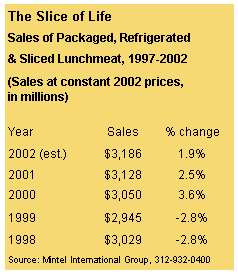

Responding to changing consumer tastes and lifestyles, purveyors of cold cuts and deli meats are developing new products and line extensions that play on flavor, form and formulation.
Efforts to shake up the category appear to be paying dividends. According to Information Resources Inc. (IRI) (Chicago), sales of refrigerated, sliced deli meat in the food/drug/mass channels (excluding Wal-Mart) were up 3% for the year ending August 11, 2002, to $3.08 billion. Earlier, the American Meat Institute (AMI) (Arlington, Va.) had reported that total luncheon meat category sales grew 6.4% between October 2000 and October 2001. Also, from 1997 to 2002, sales of refrigerated, non-sliced luncheon meat, primarily sold in delis, rose almost 11%, according to Chicago-based Mintel International Group.
Responsive product developers and marketers, reacting to trends ranging from healthful eating to convenience to a desire for bolder flavors, can take much of the credit for the category's ability to manage gains in the face of some strong headwinds.

“From a health perspective, demand for leaner deli meats continues to grow in the luncheon meat and foodservice categories, and manufacturers are offering lines of light, low cholesterol and MSG-free meat and poultry meats,” O'Connor says. “Another trend is the increase in requests for thin-sliced deli meats, either at the deli itself or pre-packaged. One theory of why thin-sliced is so popular is that it imparts more flavor because of its greater surface area when two or three slices are put on a sandwich as opposed to just one slice.”

Leaning to Lean
Recent data from the AMI appears to confirm that consumers are looking for luncheon meat that is leaner, yet not so lean that taste is compromised. An AMI study showed that, among luncheon meats described as “better-for-you,” dollar sales of those described as lean (90-94% fat free) experienced higher growth than those falling in the fat-free, light and low-fat categories, which have different fat contents. Meanwhile, “regular fat” lunchmeat—such as salami and loave products—also saw a healthy increase.Luncheon meats offering healthier formulations also appear to be gaining ground. O'Connor noted that “nitrate/nitrite-free,” “antibiotic-free” and organic lunchmeats were on display at a recent natural products show. “A fast-growing but small segment are companies that are producing meat products with 'clean' ingredient labels,” she says.
Along the same lines, Oscar Mayer last year pioneered development of a lunch meat formulation that addresses microbiological concerns. The company is sharing with the industry its findings that a combination of sodium and potassium lactate and sodium diacetate can inhibit the growth of Listeria monocytogenes.
However, despite a growing interest in providing products with a more healthful profile, companies in the deli meat business appear even more interested in giving consumers a good eating experience. Last year, for instance, Farmland rolled out a line of pre-sliced, vacuum-packed, Italian-style luncheon meats such as capicola, proscuitto and soppressata under a new Carando Deli Quick brand.
O'Connor says the move to develop bolder flavors of lunch meats is partly a response to the healthy eating trend.
“When a product is flavorful you do not have to consume as much of it to be satisfied,” she says. “With the rising incidence of obesity and diabetes, and the increasing serving size of portions, the right 'flavor balance' goes a long way toward more healthful, pleasurable eating. So, stronger flavors that encompass ethnic flavors like Thai, Latin and Indian, and traditional flavors like maple, smoked, herb, pepper and teriyaki are showing up in meats.”
Last year, for instance, Oscar Mayer introduced its Deli Style cold cuts that offer six flavors: smoked ham, brown sugar ham, oven-roasted turkey, smoked turkey, mesquite-smoked turkey and honey smoked turkey. ConAgra, meanwhile, reportedly did some work to boost the flavor profile of some of its Butterball and Healthy Choice lines, concentrating on smoky flavors.
Another trend O'Connor noted is an emphasis on higher-quality meat cuts. “Structured” luncheon meat products are increasingly giving way to products that come from a better cut.
“The desire for high-quality, whole-muscle meats tends to favor trusted brand-name products, but high-end private label products also are finding success as retailers develop their own programs,” she says.
While product development is contributing to the steady growth of the luncheon meat category, broader consumer trends also may bode well for near-term future of lunchmeats. With fewer consumers eating three square meals a day and more looking for convenience, trips to the deli for a quick sandwich or to the packaged lunch meat section of the grocery might become more commonplace.
“This trend bodes well for ready-to-eat items,” O'Connor says. “Also, be sure to watch the lunch/dinner sandwich eating trends; this category is exploding right now and is getting a lot of competition from restaurants. Supermarkets can create signature sandwiches and meals featuring ready-to-eat meats that make their delis distinctive.”
Website Resources
www.meatami.org— American Meat Institutewww.iddba.org— International Dairy-Deli-Bakery Association
www.farmland.com— Farmland
www.conagra.com— ConAgra